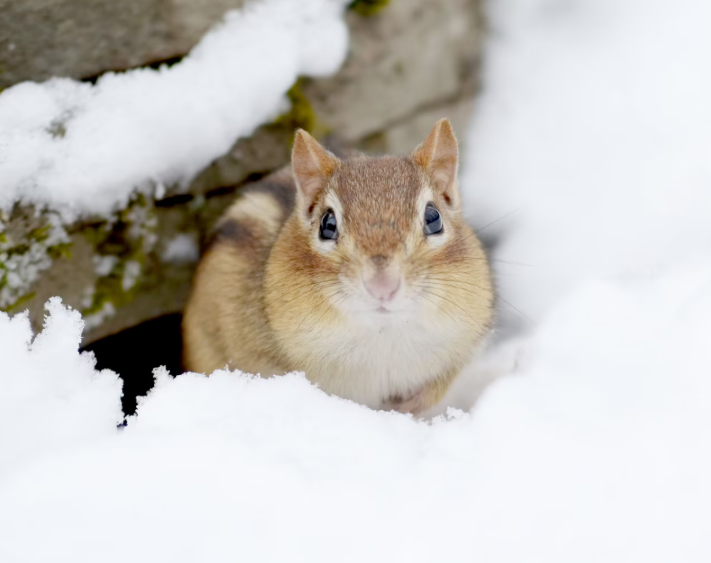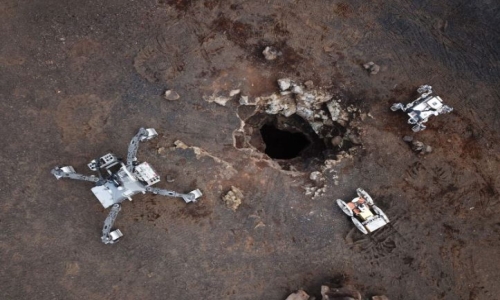


 3:15:39
3:15:39  2025-01-06
2025-01-06  989
989

While we can simply throw on a sweater or turn up the heat, wild animals must have strategies to make it through the winter months.
Take spiders. Many ground-dwelling North American species, such as wolf spiders, get through the winter by burrowing in the soil, under leaf litter, or inside logs.
“The difference in temperature between a frozen surface of snow or ice and just a few inches below cover is often surprising,” says behavioral ecologist George Uetz, a spider expert at the University of Cincinnati in Ohio. "Many spiders and insects are active in ths ‘subnivean’ environment, which is sometimes a few degrees above freezing.”
Because spiders are ectotherms and produce no body heat, their metabolism slows when the temperature drops.
“Even so, it’s not uncommon to see spiders and insects active on warm days,” Uetz says.
Many web-building spiders spin egg sacs with multiple layers of silken insulation to shelter their eggs through the winter. Black-and-yellow garden spiders, for instance, hatch their eggs in the fall, so that young spiders cluster in the egg sac all winter to emerge in masse in spring.
Some spiders also have a secret weapon: During cool autumn nights, they produce special antifreeze-like compounds that prevent ice crystals from forming inside their bodi, Uetz says—a handy trick to make it to spring without freezing solid.
Turtles brumate—and breathe—underwater
Turtles are slow in any season, but when winter approaches they really throttle down their activity.
Some species, like eastern box turtles, simply burrow into the soil, retreat into their shells, and slip into a period of inactive torpor known as brumation, which they survive by burning fat reserves.
Painted turtles spend the winter submerged on the bottom of a water body, which protects them from freezing even if the surface ices over. Because these ectotherms’ body temperatures match that of the surrounding water, the cold isn’t a problem.
Normally, these reptiles breathe air, but during winter, they’ve evolved the ability to uptake oxygen from the water and discharge carbon dioxide into it. “When ectotherms are cold, they don't need much O2, so what they can pick up from the water column is generally enough to get them through the winter,” says Jackie Litzgus, a biologist at Laurentian University in Ontario.
The turtles exchange gases via specialized blood vessels near the skin’s surface, the mouth lining, and even the cloaca—a cavity that also serves as both a waste discharge and reproductive opening.
When oxygen becomes extremely scarce, painted turtles and snapping turtles can even enter a metabolic mode that requires none. This aerobic respiration produces a dangerous buildup of lactic acid, but the turtles can cannibalize calcium from their shells to neutralize the acid buildup.
Honeybees produce heat for all
When temperatures drop, European honeybees take to their hives, where they cluster together, remaining active throughout the long winter months.
“It is unique, there is no other insect that overwinters by keeping themselves warm,” says Thomas Seeley, a biologist at Cornell University.
Worker bees gather around the queen, regulating the cluster’s composition to match fluctuations in temperature. The bees generate heat by isometrically contracting and relaxing the two sets of muscles used to move wings in flight. “Their energy expenditure is not working toward moving or doing anything else but making heat,” Seely explains.
The queen’s spot in the swarm’s center is the warmest and most comfortable, but even the outermost bees don’t freeze. As it gets colder, they press inward, improving the insulation and compacting the area that must be kept warm. “The bees in that thick outermost layer or blanket aim to keep themselves above about 50°F,” Seely says. “That keeps them alive.”
The strategy depends on months of planning. During the flower-rich summer months bees produce and store 90 pounds of honey to sustain a hive over the winter. They also choose a location wisely, heading for the very top of a hollow tree cavity, to create a warm microenvironment.
Chipmunks build a bunker
Chipmunks are members of the squirrel family, but unlike their bushy-tailed relatives, you won’t see them out and about all winter. Nor do they hibernate the entire season away, like the groundhog does before supposedly emerging to announce the timing of spring.
Instead, these small mammals hang out in elaborate burrows, tunnel and chamber systems they’ve built that connect those little holes that are chock-full of nuts, seeds, and other stored food.
Eastern chipmunks spend days in a state of torpor, during which their heart rate drops from about 350 beats to minute into the single digits, and their body temperature falls from 94°F to the ambient temperature of the burrow—as low as 40°F. But they do awaken every few days to eat and use designated toilet chambers.
Snowbirds head for warmer climes
More than 70 percent of the backyard birds in the U.S. and Canada are migratory, and many head south for the winter according to Jill Deppe, director of the National Audubon Society’s Migratory Bird Initiative.
“So even if they don’t necessarily know what those birds are, people notice that in the fall their backyards get quieter.”
Audubon’s Bird Migration Explorer maps the annual flights of more than 450 bird species traveling to warmer places—and some are mind-boggling.
The ruby-throated hummingbird weighs as much as a penny, yet on their way to Central America some of these birds cross the Gulf of Mexico—500 miles—in a single day.
They are so light, it seems they [can] just ride the winds,” Deppe says. Meanwhile, some rufous hummingbirds in the western U.S. shatter the flying-south stereotype.
“Some birds end up in places you don’t expect them,” Deppe says. “There are quite a few that actually head east, so you find them in Louisiana or Florida backyards in the winter.”
So if the weather turns cold where you are, raise a glass to the resilient animals that make it through the toughest of seasons all on their own.
Reality Of Islam |
|

A new NURBS

A research

Researchers
 9:3:43
9:3:43
 2018-11-05
2018-11-05
10 benefits of Marriage in Islam
 7:5:22
7:5:22
 2019-04-08
2019-04-08
benefits of reciting surat yunus, hud &
 9:45:7
9:45:7
 2018-12-24
2018-12-24
advantages & disadvantages of divorce
 11:35:12
11:35:12
 2018-06-10
2018-06-10
 6:0:51
6:0:51
 2018-10-16
2018-10-16
 9:30:2
9:30:2
 2021-11-12
2021-11-12
 7:32:24
7:32:24
 2022-02-14
2022-02-14
 6:14:3
6:14:3
 2023-01-18
2023-01-18
 8:19:41
8:19:41
 2018-06-21
2018-06-21
 11:11:59
11:11:59
 2023-02-01
2023-02-01
 2:13:43
2:13:43
 2022-05-27
2022-05-27
 8:39:51
8:39:51
 2022-09-23
2022-09-23
 5:41:46
5:41:46
 2023-03-18
2023-03-18
| LATEST |